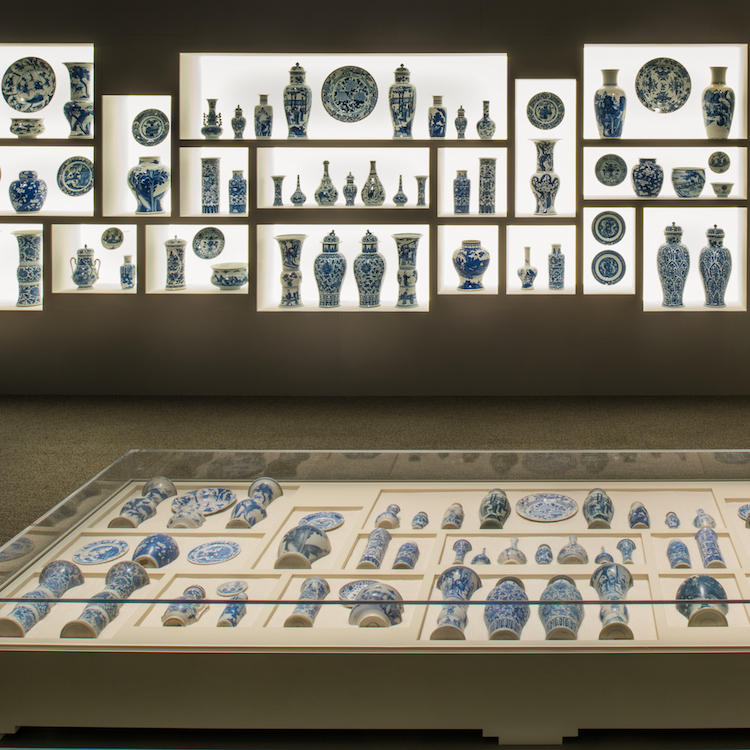WASHINGTON D.C. — American sculptor Walter McConnell explores the West’s near-fanatical fascination with blue- and-white Chinese porcelain from the 1870s through today in his installation Chinamania (July 9, 2016–June 4, 2017) at Arthur M. Sackler Gallery.
Featured Image: McConnell’s display of blue-and-white porcelains from the Freer Gallery’s permanent collection.
Chinamania

Meant to evoke a Victorian porcelain chamber, McConnell designed a display of blue-and-white porcelains from the Freer Gallery’s permanent collection.
A mania for Chinese blue-and-white porcelain swept through London in the 1870s as a new generation of artists and collectors ‘rediscovered’ imported wares from Asia. Foremost among them was American expatriate artist James McNeill Whistler. For him, porcelain was a source of serious aesthetic inspiration. For British shoppers, however, Chinese ceramics signified status and good taste. Cultural commentators of the time both embraced and poked fun at the porcelain craze. Illustrator George du Maurier parodied the fad in a series of cartoons for Punch magazine that documented what he mockingly called “Chinamania.”
More than 150 years later, American artist Walter McConnell explores Chinamania in our own time. In his exhibition, he juxtaposes two monumental porcelain sculptures, which he terms stupas – Dark Stupa and White Stupa, with 3D printed replicas of blue-and-white export wares from China’s Kangxi period (1662–1722) — similar to those that once filled the shelves of Whistler’s Peacock Room in London.
McConnell’s interest in replication and in the serialized mass production of ceramic forms began after he visited China more than a decade ago. The large kilns and busy factories at Jingdezhen prompted McConnell to look at China as an enduring resource for ceramic production.
Chinamania complements the exhibition Peacock Room REMIX: Darren Waterston’s Filthy Lucre, a contemporary installation that reimagines the Peacock Room as a resplendent ruin. Inspired by museum founder Charles Lang Freer’s collection of Asian ceramics, Waterston painted scores of vessels and arranged them on the buckling shelves of Filthy Lucre. These oozing, misshapen ceramics convey a sense of unsustainable luxury and excess. They also echo McConnell’s interest in the interplay of creativity, the mass production of aesthetic objects, and the powerful forces of materialism and conspicuous consumption.
A Theory of Everything
“The ceramic archive recycled and compounded to excess seems to be evidence of a collective unconscious—vastly weird and wonderful—that is at the core of our acquisitional urges and desires.” —Walter McConnell
After traveling to China in 2002 and witnessing the mind-boggling ceramics production sites in Jingdezhen, McConnell set out on his series A Theory of Everything. Each sculpture in the series combines hundreds of individual elements—imitation Ming vases, smiling Buddhas, grim reapers, historical icons and cartoon characters—that the artist casts from molds recycled from the hobby industry. After the mineral-rich crystalline glazes on the figures are fired at extremely high temperatures, they create complex surface textures and rich tonal variations.
McConnell refers to his ceramic assemblages as stupas due to their simple conical forms. Stupas, which originated in India and spread throughout the Buddhist world, are freestanding structures made to hold holy texts or remains of saints. McConnell’s stupas elevate mundane objects that have been endlessly replicated for popular consumption. By comparing his extravagant piles of kitsch to a sacred structure, McConnell asks us to think about the meaning of our own “acquisitional urges” and the desire to accumulate.
The relationship of ‘the ceramic archive’ to collecting and display has a long history in the West. During the Victorian and Gilded Ages of the late nineteenth century, connoisseurs and consumers vied to acquire exported Chinese blue-and-white ceramics. A Theory of Everything brings the ceramic archive, recycled and compounded to excess, into the twenty-first century. As McConnell says, this is evidence not only of a collective unconscious but also of the larger cultural contexts in which objects accrue value and meaning.
Watch how McConnell along with Freer|Sackler staff installed Dark Stupa and White Stupa:
Video by: Hutomo Wicaksono
Read more about the exhibition:
Porcelain Frenzy
Multiples, Replicas and Facsimiles
Porcelain Production at Jingdezhen
He is represented by Cross-Mackenzie Gallery in Washington, D.C.
Text (edited) from Freer Gallery of Art | Arthur M. Sackler Gallery.
Images: ©Maxwell Mackenzie
Do you love or loathe these works from the worlds of contemporary ceramics and contemporary ceramic art? Let us know in the comments.











Does anyone else take issue with the fact that, it’s 2017 and a white dude chose to call his exhibition ‘Chinamania’?
Does anyone else have a problem with the fact that the author of this article glosses over the historical origin of the demeaning an condescending term ‘Chinamania’ yet somehow doesn’t have a problem with the fact that a white artist chose to still call his exhibition by that name, simply because the artist “Traveled to China in 2002”?
That’s like saying that any white, American, man who has traveled to Africa has earned the right to use the ‘N’ word, and exoticise African culture…
Clearly there is no denying that the exhistance of porcelain in the western world at all, is due to cultural appropriation, but if words matter at all in 2017, it should be acknowledged that a white dude calling his show ‘Chinamania’ should have been thought about a little bit longer before it was done, and at the very least should be most talked about in a review of the exhibition…
Just to be factual: the title, “Chinamania” is not the creation of this “white dude.” Rather, the title was chosen by the curator, Lee Glazer from the Freer-Sackler Galleries of the Smithsonian. Also, the term Chinamania is coined by a 19th Century English cartoonist to lampoon the middle class obsession with Chinese porcelain. To suggest that the work of this artist is somehow connected to an ethnic slur is absurd and embarrassingly misinformed.
So glad to see Walter’s work get the attention it deserves.
Bravo!!!
Credit the fantastic images above to ©Maxwell Mackenzie
and the time lapse video to Hutomo Wicaksono. Thanks
Images credited. Beautiful work!